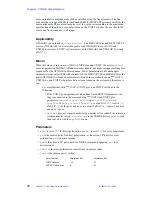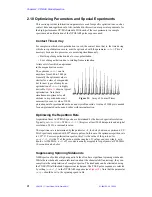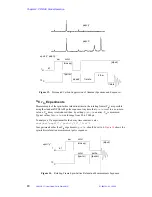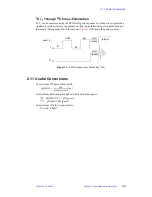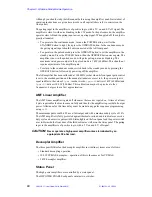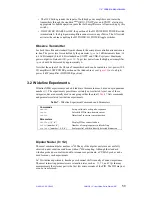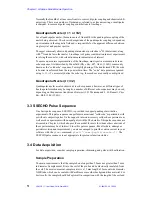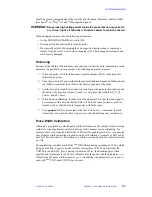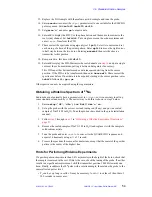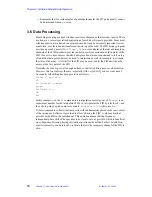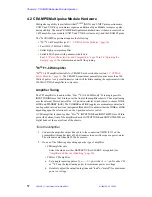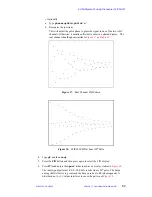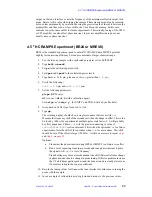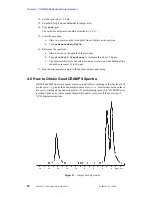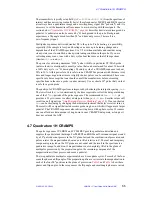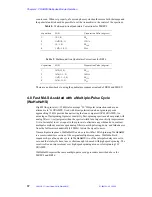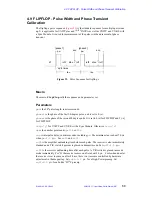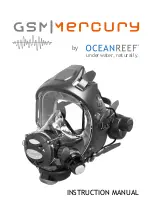
Chapter 3. Wideline Solids Module Operation
53
VNMR 6.1C User Guide: Solid-State NMR
01-999162-00 C0402
3.5 Standard Wideline Samples
Two standard wideline samples are provided with the system, malonic acid-d
4
for
2
H and
sodium nitrate for
23
Na wideline NMR. These samples are provided as an aid to becoming
familiar with the operation of the wideline module and do not have any associated
specifications.
Obtaining a Wideline Spectrum of Deuterium
The deuterium powder pattern spectrum of malonic acid-d
4
can be obtained in the
following manner (this is not the only way to operate the wideline module, but does provide
a convenient starting point):
1.
Determine the 90
°
pulse using a solution, in this case, 2% D
2
O (for most other
quadrupolar nuclei, a 1 M solution of a salt in water should be used). Put the relevant
tuning rod into the probe. Connect the correct coil in the correct pair of connectors
on top of the probe body. Refer to the probe installation manual for details on setting
up the wideline probe.
2.
Place a sealed sample of 2% D
2
O in the probe and put the probe into the magnet.
Connect body air, VT gas and the “Normal” connector on the magnet leg to the
probe. No filters are necessary. Make sure that the 30–60 MHz 1/4-wavelength cable
is on the magnet leg.
3.
Enter
setup('H2','d2o')
dm='n'
su
. Tune the probe as described in the
probe installation manual.
4.
Now, instead of the observe channel, connect the lock channel to the probe. Lock the
spectrometer in the usual way.
The spectrometer can now be shimmed using
acqi
, but there is no point trying to
obtain a resolution that is markedly better than the lines to be observed, so that only
the gradients X, Y, Z1 Coarse, and Z2 Coarse need be optimized.
5.
Make sure that the lock and spinner are deactivated by selecting LOCK OFF, SPIN
OFF, SPIN=0 and setting
lockpower=0
.
6.
Replace the lock connection with the observe channel. Check the tuning and then
make sure that the probe is connected to the “Normal” position on the preamplifier.
7.
If not already done, reset the solids cabinet, and make sure the broadband 1 kW
amplifier is on and that no interlocks are activated. Set the switch panel so that the
LOWBAND is on HI POWER.
8.
Set
sw=1E5
pw=2
np=1E4
d1=4
nt=1
. Set
tpwr
to the standard value for the
system. If no value has been determined previously, set
tpwr=55
.
9.
Set
gain='n'
and acquire a spectrum. Phase correct the result and ensure that the
spectrometer is working correctly. If necessary, use
movetof
to place the D
2
O
signal exactly on resonance.
10. Check these adjustments by reacquiring a spectrum.
11. Array
pw
to determine the 180
°
or 360
°
pulse width. Set
gain='y'
(because
arrayed experiments cannot use Autogain) and acquire the data. Determine the 90
°
pulse width to 25 ns resolution.
12. Set
pw
and
pw90
to the 90
°
pulse width value.
This completes the calibration procedure.

